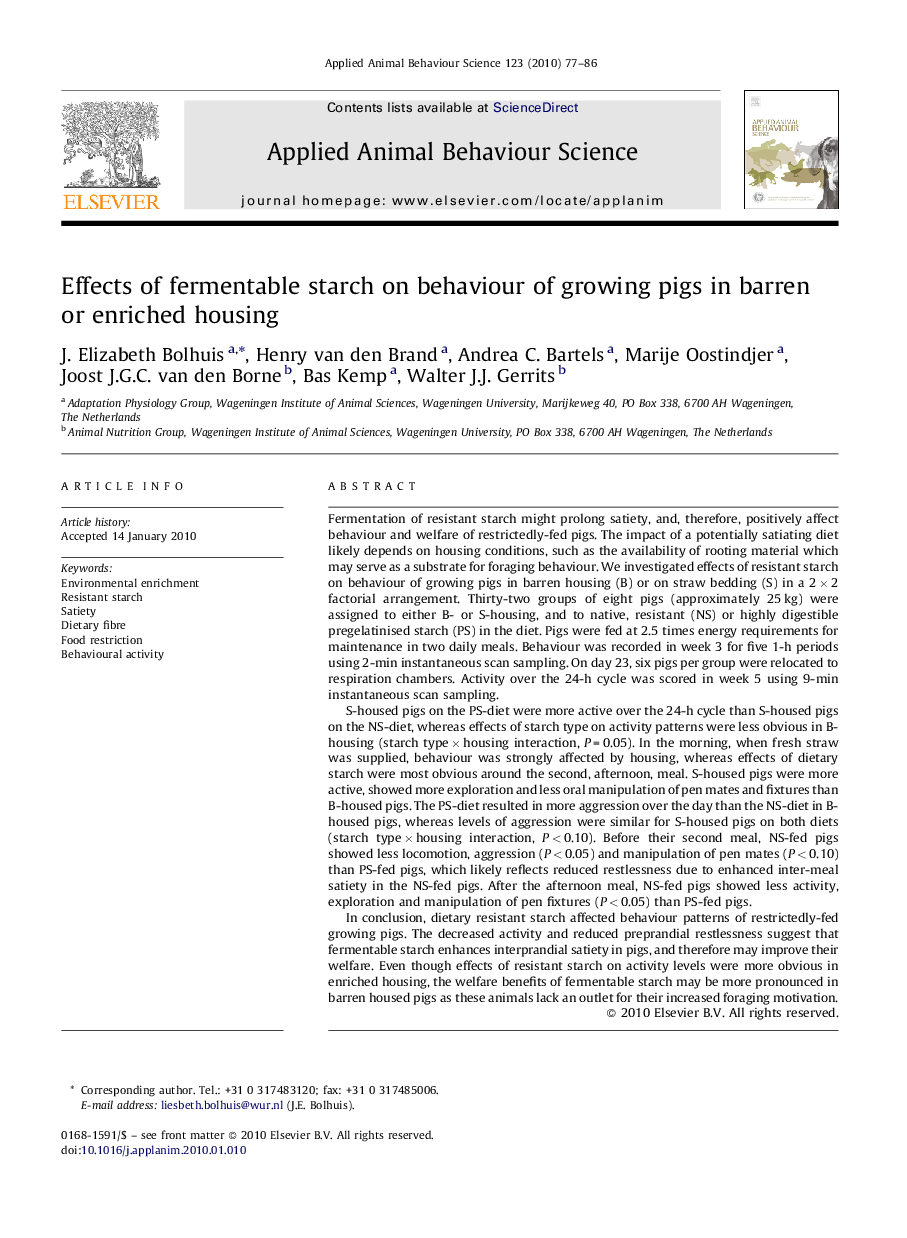| کد مقاله | کد نشریه | سال انتشار | مقاله انگلیسی | نسخه تمام متن |
|---|---|---|---|---|
| 4523394 | 1625402 | 2010 | 10 صفحه PDF | دانلود رایگان |

Fermentation of resistant starch might prolong satiety, and, therefore, positively affect behaviour and welfare of restrictedly-fed pigs. The impact of a potentially satiating diet likely depends on housing conditions, such as the availability of rooting material which may serve as a substrate for foraging behaviour. We investigated effects of resistant starch on behaviour of growing pigs in barren housing (B) or on straw bedding (S) in a 2 × 2 factorial arrangement. Thirty-two groups of eight pigs (approximately 25 kg) were assigned to either B- or S-housing, and to native, resistant (NS) or highly digestible pregelatinised starch (PS) in the diet. Pigs were fed at 2.5 times energy requirements for maintenance in two daily meals. Behaviour was recorded in week 3 for five 1-h periods using 2-min instantaneous scan sampling. On day 23, six pigs per group were relocated to respiration chambers. Activity over the 24-h cycle was scored in week 5 using 9-min instantaneous scan sampling.S-housed pigs on the PS-diet were more active over the 24-h cycle than S-housed pigs on the NS-diet, whereas effects of starch type on activity patterns were less obvious in B-housing (starch type × housing interaction, P = 0.05). In the morning, when fresh straw was supplied, behaviour was strongly affected by housing, whereas effects of dietary starch were most obvious around the second, afternoon, meal. S-housed pigs were more active, showed more exploration and less oral manipulation of pen mates and fixtures than B-housed pigs. The PS-diet resulted in more aggression over the day than the NS-diet in B-housed pigs, whereas levels of aggression were similar for S-housed pigs on both diets (starch type × housing interaction, P < 0.10). Before their second meal, NS-fed pigs showed less locomotion, aggression (P < 0.05) and manipulation of pen mates (P < 0.10) than PS-fed pigs, which likely reflects reduced restlessness due to enhanced inter-meal satiety in the NS-fed pigs. After the afternoon meal, NS-fed pigs showed less activity, exploration and manipulation of pen fixtures (P < 0.05) than PS-fed pigs.In conclusion, dietary resistant starch affected behaviour patterns of restrictedly-fed growing pigs. The decreased activity and reduced preprandial restlessness suggest that fermentable starch enhances interprandial satiety in pigs, and therefore may improve their welfare. Even though effects of resistant starch on activity levels were more obvious in enriched housing, the welfare benefits of fermentable starch may be more pronounced in barren housed pigs as these animals lack an outlet for their increased foraging motivation.
Journal: Applied Animal Behaviour Science - Volume 123, Issues 3–4, March 2010, Pages 77–86